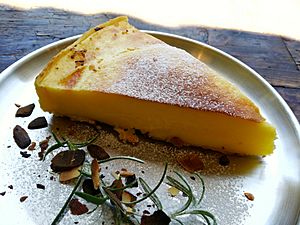Flan (pie) facts for kids
Not to be confused with crème caramel, also known as flan or flan de leche.

A slice of flan on a plate
|
|
| Type | Dessert or snack |
|---|---|
| Place of origin | Europe |
| Region or state | Global |
| Associated national cuisine | Roman cuisine |
| Serving temperature | Room temperature or cold |
A flan, in British cuisine, is an egg-based dish with an open, rimmed pastry or sponge base containing a sweet or savoury filling; examples are Bacon and egg flan or custard tart.
History
Flan is known in Roman cuisine. It was often a savory dish, as in "eel flan"; sweet flans were also enjoyed.
In the Middle Ages, both sweet and savory flans (almonds, cinnamon & sugar; cheese, curd, spinach, fish) were very popular in Europe, especially during Lent, when meat was forbidden.
Etymology
The English word "flan", and the earlier forms "flaune" and "flawn", come from the Old French flaon (modern French flan), in turn from the early Medieval Latin fladō (accusative fladōnem), of Germanic origin, from an Indo-European root meaning "flat" or "broad".

All content from Kiddle encyclopedia articles (including the article images and facts) can be freely used under Attribution-ShareAlike license, unless stated otherwise. Cite this article:
Flan (pie) Facts for Kids. Kiddle Encyclopedia.
